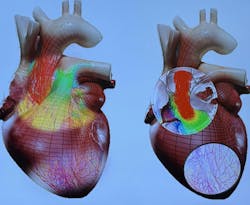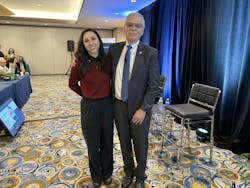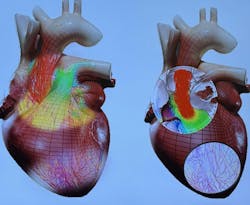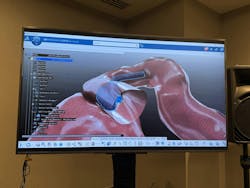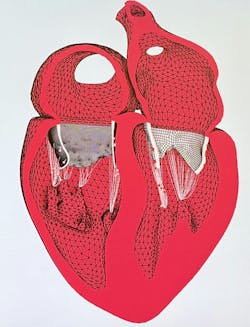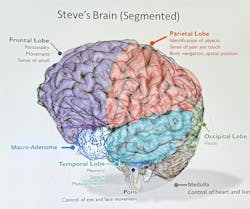Virtual Human Modeling: From Concept to Life-Saving Technology
In a remarkable twist of fate, the very technology that Dr. Steve Levine dedicated his career to developing became a literal lifesaver for him. As the senior director of virtual human modeling at Dassault Systemes, Levine spent nearly 15 years pioneering the concept of virtual twin human experiences.
The Birth of Virtual Twin Modeling
When Levine first began exploring virtual human modeling, it was largely uncharted territory. The concept, although still emerging, was rooted in a vision of harmonizing products with life.
“At the time, we were bringing life or experiences to products, so you didn’t just look at them and see how they looked. You can experience how they had to simulate the performance of the product,” he said during a press conference at 3DExperience World on Feb. 24. “I was leading the strategy for our simulation brand…and was challenged at the time to imagine how to simulate not just a product experience, but life experience, and that led to what we know are calling ‘virtual.’”
The evolution of the Living Heart Project emerged from a real-world need. Levine’s daughter Jesse was born with a rare heart condition known as dextrocardia, where the heart is mirrored from its normal position. As she grew, her condition posed significant uncertainties for her health and treatment options, leaving doctors looking for potential risks and complications.
Witnessing the limitations of traditional medicine firsthand propelled Levine to create a virtual twin of Jesse’s heart. This groundbreaking project—the Living Heart Project—aimed to provide insights before any medical interventions were considered.
The Power of Collaboration
The success of the Living Heart Project was not the result of a single expert, but rather an extensive collaboration among roughly 165 organizations worldwide—comprising thousands of individuals—including regulatory bodies like the U.S. FDA. Launched in 2014, the project aimed to create a sophisticated virtual model that could predict heart behaviors and test potential treatments without risk to the patient.
The endeavor not only pulled together cardiologists, engineers and researchers, but also focused on overcoming the complex regulations surrounding medical technologies. Through years of perseverance, the project garnered the FDA's support, enabling the use of virtual twins in clinical settings and enhancing the accuracy of medical treatments.
Real-Life Implications
Jesse was able to thrive into adulthood, and her transition into medical training as a pediatric neurologist reflects the personal investment both she and her father have in this innovative space. One day, as Dr. Jesse Levine was preparing for her rotations, she received an e-mail from her father that would change their lives. The e-mail contained a head CT of his brain, where the findings indicated a pituitary macro adenoma—a large tumor pressing on critical structures in his brain.
The senior Levine, who was deeply immersed in the virtual twin technology he had spent years developing, now faced a personal crisis. Armed with her medical knowledge and training, Jesse Levine investigated her father’s condition diligently. Knowing the urgency of the situation, she quickly identified the need for a comprehensive understanding of her father’s complex anatomy, which led her to leverage the very virtual twin technology he had pioneered.
From Living Heart to Living Brain to More
Levine’s surgery was a delicate operation, particularly due to the tumor’s location and its entanglement with critical structures such as the optic nerve and blood vessels. By utilizing a virtual twin model of his brain, the surgical team was able to develop a strategic plan that allowed them to visualize and navigate his intricate anatomy precisely.
This technology not only facilitated a less invasive approach but also transformed the nature of surgery itself. During the operation, which lasted about 12 hours, the surgeons relied on the virtual model to guide their movements. Instead of traditional open surgery that would involve significant cranial manipulation, they used a minimally invasive approach: navigating through the nasal passages to access the tumor.
The convergence of personal and professional challenges sparked an innovative approach toward addressing medical issues. Jesse’s advocacy and her first-hand experience with the healthcare system allowed them to navigate a crisis with hope and resourcefulness, and that is how the Living Brain Project was born.
Levine reflects on this fortunate alignment of circumstances: “I lived. I’ve spent a lot of time with the community and often spoke about the value of the virtual twin, not just to the medical side, but to the patient side.
“I represented the patient’s perspective, largely as the father of an actual patient, and the importance of understanding what's happening to you, the anxiety that you go through as a patient,” he continued. “Being able to actually understand it—have Jessie take me through it very systematically—I knew what my risks were.”
As the Living Heart Project celebrates its 10th anniversary, Levine outlines an ambitious future for it beyond just the heart. The team is now exploring virtual models for other vital organs and parts of the body, such as the liver, lungs, kidneys, joints and eyes. The next phase involves refining these models to make them adaptable and parametric, allowing for faster and more efficient simulations.
“We’ve now created what’s called a parametric version…where you can change the size, the shape, the depth, all the different features to really push them up, which means the time to craft it, to make it look like your heart, or my heart, goes down from days to minutes,” he announced. “It also then becomes more accessible to machine operations.”
We have heard about being AI-enabled, Levine said, “so it now speaks the language of the computer…If we needed to do surgery on Jesse, we could then use our new heart to say, okay, perform 1,000 surgeries on her. The computer could do that. Now we don’t need a doctor to do that and then tell us which one would be the best outcome, not just while she’s lying on the table, but we could also then say what will happen if she exercises, when she’s sleeping, when she’s running, jumping. We can do all of that.”
This means that instead of days, crafting a new model may take minutes, paving the way for unprecedented possibilities and personalized medicine. Levine and his team also have their sights set on problems like space-related health issues, collaborating with NASA to ensure astronauts maintain their sight during extended missions. This multidimensional approach shows the versatility and potential of virtual human models to address a range of medical and scientific challenges.
About the Author
Sharon Spielman
Technical Editor, Machine Design
As Machine Design’s technical editor, Sharon Spielman produces content for the brand’s focus audience—design and multidisciplinary engineers. Her beat includes 3D printing/CAD; mechanical and motion systems, with an emphasis on pneumatics and linear motion; automation; robotics; and CNC machining.
Spielman has more than three decades of experience as a writer and editor for a range of B2B brands, including those that cover machine design; electrical design and manufacturing; interconnection technology; food and beverage manufacturing; process heating and cooling; finishing; and package converting.
Email: [email protected]
LinkedIn: @sharonspielman
Facebook: Machine Design
YouTube: @MachineDesign-EBM
